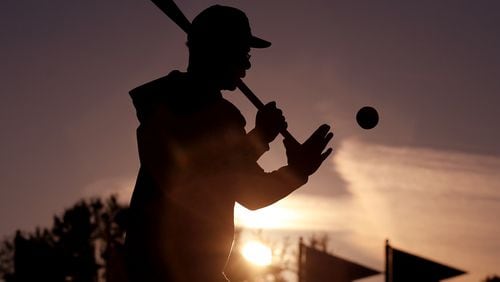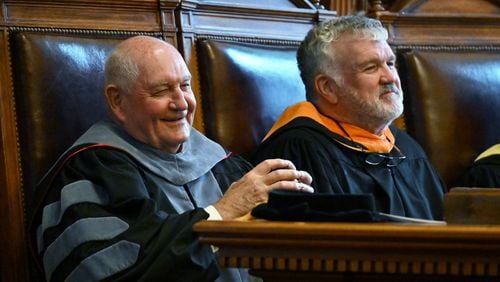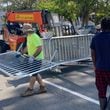LAKE BUENA VISTA, Fla. – Twenty years ago this spring the Braves new third base coach, Ron Washington, struck up a relationship that has remained steady through the considerable turmoil in his life.
It was 1997 at the Oakland A’s spring camp when Washington stopped at the display of a start-up Canadian bat company and began sampling the wares. Turned out that day he was grabbed by one piece of lathed maple as much as he grabbed it.
“I picked it up and said, dammit, this is what I’ve been looking for,” Washington remembered.
Baseball at its best is a collection of modest little tales, small delights and mini-fables that perpetuate our belief in the charms of the game despite all modern evidence to the contrary.
Here’s one about a man and his fungo bat.
That is the thin-barreled bat employed by coaches to largely hit grounders to infielders. It is a common instrument of training. It’s the skinny bat that all the other bats make fun of.
In Washington’s case, though, one fungo bat has become like a natural extension of his arms. To him it is no different than the Stradivarius is to the violinist or the truffle to the chef.
It’s all in the feel. This bat is a little heavier at the end, a heft that he has been unable to recreate in any other bat. “I had one company take this into the factory and try to duplicate it. Couldn’t do it,” he said.
With it, Washington can steer a baseball to all precincts of an infield, moving his guys left and right in a practice he precisely choreographs. With it, he has hit more fungoes in 20 years then any corporate accountant could ever total.
“And look at that. Don’t even have a dent in the wood,” Washington said.
Nodding to another fungo bat leaning up against the Braves spring dugout, Washington said, “When you flip that bat head there, it keeps going. When I flip this one, it stops. That’s the difference. I can hit the ball harder off that other one because it’s lighter. I can really smoke balls with that. But I’m not into smoking balls at infielders. I want infielders to catch ground balls comfortably.
“I can put the ball where I want to. If I had never put my hand on this, I would have figured out how to hit that one. But I didn’t.”
This bat accompanied Washington through the climb up the coaching ranks in his post-playing second act, which began in Oakland. And through eight seasons as Texas’ manager, when he’d still hit infield during the spring. Through his managerial extremes of two runs to the World Series (2010 & '11) and acknowledged cocaine use as well as an abrupt resignation to reportedly try to repair his marriage. It is with him still, on this new assignment with the Braves, where part of the job description seems to be defying his age (64) by bouncing around camp with more energy than those players 40 years younger.
The bright green and gold coloring on the bat (A’s colors) has long ago worn away, leaving behind a dull yellowish hue. Gone too is the label – it’s a Sam Bat. There’s only the faintest trace that it was ever burned into the wood.
Washington said he has known some old-time coaches so deft with a fungo bat that they practically could “pitch” batting practice with it. “I’m pretty good, but I’m not that good,” he laughed.
B.B. King named his guitar “Lucille.” Bobby Jones’ putter was “Calamity Jane.” But Washington has thus far resisted the notion of humanizing his instrument. Even though it has been very, very good to him.
More than helping to make him a proficient striker of ground balls, this bat has even earned Washington a little money on the side.
It was in the early 2000s, while he was still coaching with the A’s, when Washington took a dare from outfielder Jermaine Dye.
Stand a few feet up the third base line from home plate – where coaches usually position themselves to hit ground balls to the right side of the infield. Hit a ball that would carry into shallow centerfield and into the bucket where batting practice balls are deposited. I’ll give you $1,000 if you can do it before the season is over, Dye told Washington.
Oh, also the screen that guards the player collecting those balls thrown in from the outfield stays up. Just to make the angle even more severe.
Daily, Washington closed batting practice by taking a dozen or so shots at the distant bucket. He was the golfer playing for nothing but a hole in one. When he just grazed the bucket, it was cause for much woofing.
Then, on the final month of the season, Washington dropped one in the bucket. Washington had won the fungo lottery. He happily recalls the team meeting where Dye peeled off 10 $100 bills.
Little wonder that when Washington reports to spring training, he doesn’t ship his fungo bat with the rest of the equipment. It goes with him on the drive south. “I don’t go anywhere without it,” he laughed.
"And when season is over and I walk out of that clubhouse,” he said, “it’s going to be in my hand. I’ll put it in my truck and take it home.”
Just like it was a member of the family.
About the Author







